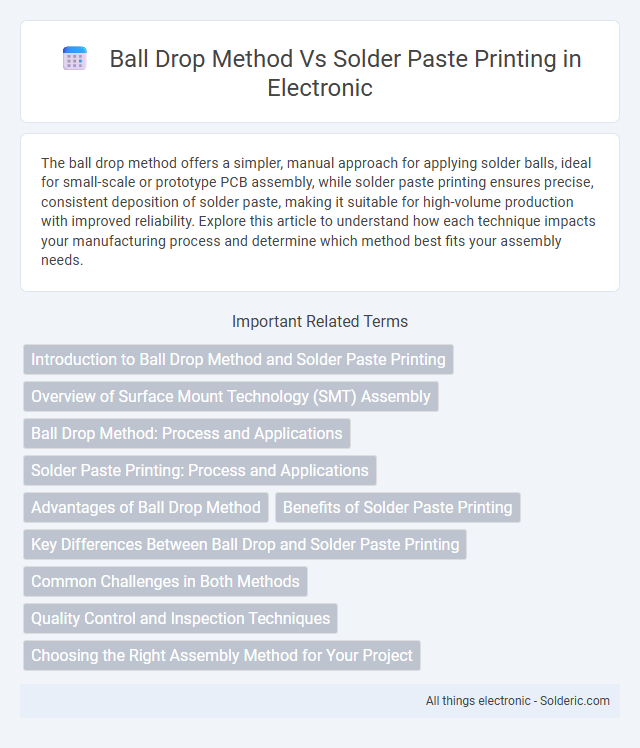The ball drop method offers a simpler, manual approach for applying solder balls, ideal for small-scale or prototype PCB assembly, while solder paste printing ensures precise, consistent deposition of solder paste, making it suitable for high-volume production with improved reliability. Explore this article to understand how each technique impacts your manufacturing process and determine which method best fits your assembly needs.
Comparison Table
| Aspect | Ball Drop Method | Solder Paste Printing |
|---|---|---|
| Process Type | Manual placement of solder balls | Automated stencil printing of solder paste |
| Application | Used primarily in BGA (Ball Grid Array) assembly | Used in surface mount technology (SMT) PCB assembly |
| Precision | Lower accuracy, depends on manual alignment | High precision with stencil-controlled deposition |
| Speed | Slower due to manual handling | Faster, suitable for mass production |
| Material Waste | Higher due to manual errors and excess balls | Lower, controlled paste volume |
| Equipment Cost | Lower initial equipment cost | Higher initial investment in printing machines |
| Consistency | Variable consistency | High repeatability and uniformity |
| Suitability | Best for small batches or prototyping | Ideal for large-scale PCB manufacturing |
Introduction to Ball Drop Method and Solder Paste Printing
The Ball Drop Method involves precisely depositing solder balls onto PCB pads to create reliable connections for components, especially in BGA assemblies. Solder paste printing uses a stencil to apply solder paste uniformly on PCB pads before component placement and reflow soldering, enabling efficient mass production. Both techniques are essential for achieving high-quality solder joints, with the Ball Drop Method offering targeted application and solder paste printing supporting automated processes.
Overview of Surface Mount Technology (SMT) Assembly
Surface Mount Technology (SMT) assembly involves precise placement of components onto printed circuit boards (PCBs) using methods such as the ball drop and solder paste printing. The ball drop method places solder balls directly onto pads before component placement, offering controlled solder volume for fine-pitch devices. Solder paste printing applies a uniform layer of solder paste through a stencil, enabling efficient mass production and reliable solder joints, which can improve your assembly yield and consistency.
Ball Drop Method: Process and Applications
The Ball Drop Method involves depositing precise solder balls onto PCB pads through a controlled drop mechanism, ensuring accurate placement and uniform solder volume. This technique is commonly applied in fine-pitch BGA assembly and prototypes where solder paste printing may face challenges with stencil alignment or paste smearing. Its precision and consistency enhance solder joint reliability in high-density interconnects, contrasting with the broader, stencil-dependent solder paste printing process.
Solder Paste Printing: Process and Applications
Solder paste printing involves applying a precise layer of solder paste onto PCB pads using a stencil, enabling accurate component placement in surface-mount technology (SMT) assembly. This method ensures strong electrical connections and consistency across high-volume production runs, making it ideal for automated manufacturing of complex, multi-layer circuit boards. Common applications include consumer electronics, automotive systems, and telecommunications devices, where reliability and precision are critical.
Advantages of Ball Drop Method
The Ball Drop Method offers precise control over solder ball placement, significantly reducing bridging and misalignment issues compared to solder paste printing. This technique enhances joint reliability by minimizing solder volume variation, which improves the performance of fine-pitch components and complex PCB assemblies. Your manufacturing process benefits from increased yield rates and reduced rework costs due to the consistent and repeatable solder deposition achieved with the Ball Drop Method.
Benefits of Solder Paste Printing
Solder paste printing offers precise control over the volume and placement of solder, significantly improving joint reliability and reducing defects compared to the ball drop method. This technique enhances process repeatability and yields higher production consistency, especially important in fine-pitch and high-density PCB assemblies. Automated solder paste printing also accelerates throughput while minimizing solder waste and rework costs.
Key Differences Between Ball Drop and Solder Paste Printing
Ball drop method applies solder balls directly to PCB pads, enabling precise placement primarily in BGA rework or repair scenarios, while solder paste printing involves applying a uniform solder paste layer through a stencil for mass SMT assembly. Ball drop technique offers localized control without stencil requirements, improving flexibility on small or complex boards, whereas solder paste printing achieves high throughput and consistent volume across multiple pads simultaneously. Differences in process speed, application precision, and suitability for production scale distinguish ball drop as ideal for rework and solder paste printing as the standard for initial surface mount manufacturing.
Common Challenges in Both Methods
Both ball drop and solder paste printing methods face common challenges such as achieving precise alignment and consistent deposition to ensure reliable electrical connections. Variability in material properties and environmental factors can lead to defects like bridging, insufficient solder volume, or poor wetting, impacting overall assembly quality. Managing these challenges requires stringent process control and regular equipment calibration to maintain high yield and reduce rework rates.
Quality Control and Inspection Techniques
Ball drop method offers quick visual inspection for solder joint formation but may lack consistency in detecting voids or misalignment compared to solder paste printing. Solder paste printing utilizes automated optical inspection (AOI) systems and X-ray inspection, providing detailed quality control by identifying defects like insufficient paste volume or bridging. Your production quality benefits from combining the precise application of solder paste printing with rigorous inspection techniques to ensure reliable, defect-free solder connections.
Choosing the Right Assembly Method for Your Project
Choosing the right assembly method for your project depends on factors like component size, accuracy requirements, and production volume. The ball drop method offers precise placement for fine-pitch components, while solder paste printing ensures consistent solder application for high-volume surface mount technology (SMT) production. Your decision should balance cost-efficiency, assembly speed, and reliability to achieve optimal manufacturing results.
Ball drop method vs solder paste printing Infographic

 solderic.com
solderic.com